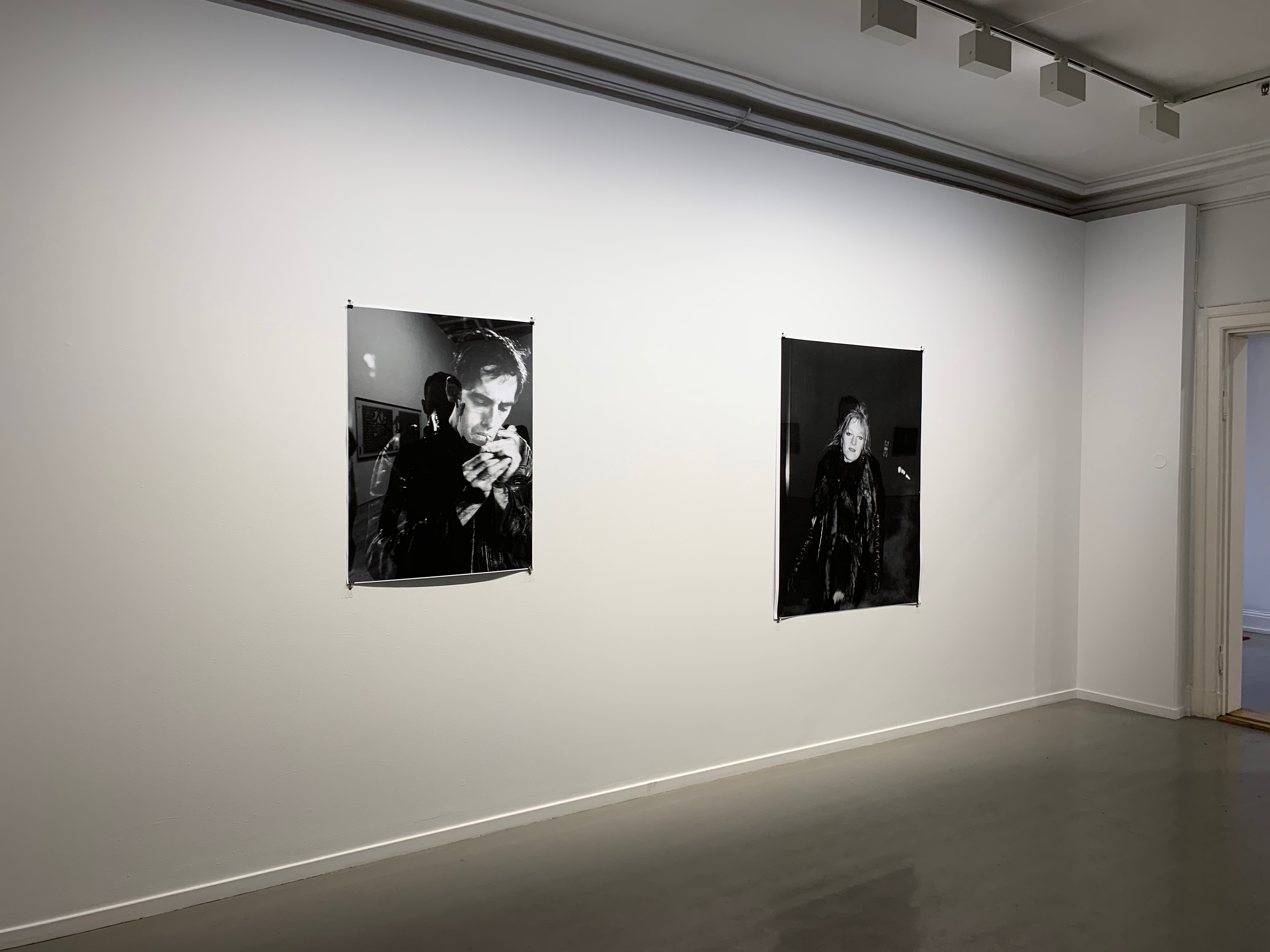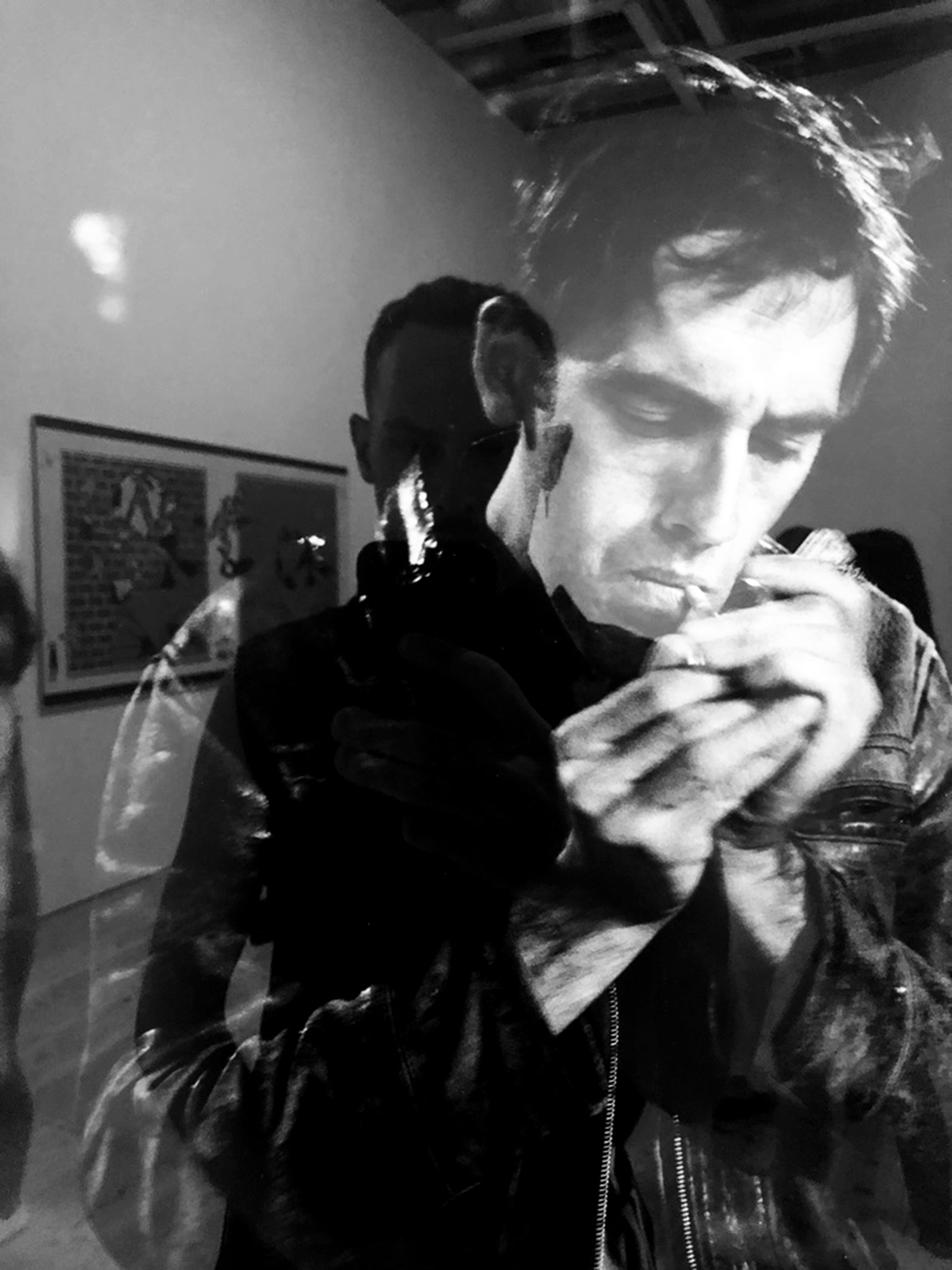presented at Oslo Kunstforening while in residence at PRAKSIS, Oslo (2019)

Ever since cameras were invented in 1839, photography has kept company with death. Because an image produced with a camera is, literally, a trace of something brought before the lens, photographs were superior to any painting as a memento of the vanished past and the dear departed. (1)
Photographs have the kind of authority over the imagination today, which the printed word had yesterday, and the spoken word before that. They seem utterly real. (2)
Reflecting. Containing. Death.
Projecting. Archiving. Desire.
In an image.
My idol worship is a desire to identify with figures from the past by engaging the spirit of queerness that passes through us, beyond the singular body. It is like a wave of stardust sticking to our minds and building constellations. These arrangements hold us close but with agile permeability, jostling and careful with the integrity intrinsic to the thousands of knots tying together a giant and confusing fishing net. The confusion is only for those who cannot feel the spirit, who are too well adjusted to normativity and accept the structures they are given. For those maladjusted the net builds an alternative narrative and context to the dominant prescriptions of identification (race, gender, ability, geography, sexuality, class, species). This net is no utopia; it allows the forceful tides of the world to come in and through, destabilizing our positions. In constant flux but together.
I enjoy idol worship. Not idolatry without reflexivity and criticality. My idols are not forever. Their positions in my lexicon are not static. They can be exhausted and denounced.
He stayed by himself and played fantasy. He lived in a world where he could be a mother or a father or a husband or a wife or a passive object or an aggressive force. He could be whatever felt like him. Some days he wore his grandmother’s long dresses and some days he wore his own short pants. He was Rita and Lana and June as often as he was Van and Cary and Tyrone. He was glamorous when he woke up and seductive at night. (3)
My experience is both unique and one of many. I think of the original photographs as icons; images people can encounter and behold. They are memorials. They are containers for our desires. When I was a teenager I hung posters and magazine pages of my favorite singers around my bedroom so as I fell asleep and woke up I was the center of a constellation of inspiration. This is not a fixed position. It’s a kind of unorthodox conjuring. It is not about ownership or originality. Rather it acknowledges the influence of others on a life, thoughts, desires, behaviors. How does a queer person locate lineages out of the bounds of biology and heternormative inheritance?
These photographs are less about me and more a methodology of queer identification across time. What are the rules to homage? How do heteronormative conventions dictate where and when we allow ourselves to feel the queer spirit pass through us? Some people may find these works to be irresponsible, theft, or forgery. I don’t think the queer spirit plays by these imperialist notions of ownership. Queerness is shifting and dislocating and dissident. To queer the methods of identification is a decolonizing of the mind from the dominant and often reductive terminology of what constitutes the self. This act changes how we might see and relate to each other.

I feel death as a queer thing; not to be glamorized but to be considered in a material sense. When a person dies they no longer maintain ownership over their narrative; instead it cracks into thousands of pieces and is held, transferred, to the many who knew them or who wish to know them. These pieces are not simply the past, but live with us and shape our reality as we carry them in our ideas, actions, and references. Archives are not only controlled objects in our institutions but immaterial things passed around without fixed rules. Archives can be secrets, gossip, nonsense. Archives accumulate, transmute, complicate. Each person has their own experience and interpretation of an archive. How we legitimize these complexities for ourselves doesn’t need to adhere to the rules of academia. Our inquiry is already legitimate. There is, however, a responsibility to our inquiries; to lay bare our research, acknowledge our position to it, and not claim ownership or dominate the read of the history. There is no neutral gaze, no neutral read, no singular interpretation of any archive. My method is rooted in transhistorical curiosity; the desire to know more about this world by locating, in and around my body, how I carry knowledge of the disasters and possibilities of the past, present, and future.
A photograph simplifies by capturing a single gaze. It becomes complicated as an image to be circulated and contemplated. The freezing of time in the image furthers this paradox: these portraits depict a moment, referred to as the past, but shown in the present. The result is an accumulation of events that build on the original source event long after the owners (photographer and subject) of the event and image will have control of it. This is the loophole, or temporal drag, where I feel the agency to remake the image by simply rephotographing it to include my reflection. The accumulating document. Virginia Woolf writes: “The eye is connected to the brain; the brain with the nervous system. That system sends its messages in a flash through every past memory and present feeling.”
These photographs are idealizations. They contain their subject in an optimistic or abstracted moment; cropping out the realities that shaped the event. Physical, emotional, and material realities are omitted. I can interpret Cookie Mueller might be living her “best life”. Relaxed, candid, composed, well-lit, elegant. The reality is: while carrying the difficulties life delivers in and around our bodies, there are moments of beauty. I felt that beauty when I approached these portraits. An aesthetic moment is only part of my experience, however. I cannot leave the images at first glance. For me these portraits demand a deeper read to build context; they are not generous, disturbing or informational enough in their composition to present the socio-political facts that shape the moment and the person.

My photographs feel messy. At first glance it may appear to be an original Peter Hujar or perhaps a Steven Arnold reproduction. A closer look reveals inconsistencies in the image; the reflection of my body, gallery lights, other artworks, an exit sign, poor resolution. It’s a forced double image; my strong desire, even desperation, to interact with the past. I can accuse myself of an easy romanticization but the relation becomes complicated when I realize the meaning in these deaths; the political moment I was born into, the lasting and growing effects of these queer thinkers and makers being absent from mentoring my thesis, giving talks at art schools, and continuing their practices into this moment. What plays would Charles Ludlam have staged during the Trump administration? Would Peter Hujar have taken his camera to Ground Zero? Would Steven Arnold use Photoshop? My photography is a reminder that these lives were cut short but their work leaves a effect, rippling over time; the stardust. They live within us, within the ideas, materials, and relationships they left behind. When I felt the echos and ripples coming from these portraits, I recaptured them. Unfrozen and unfinished.
In an era of information overload, the photograph provides a quick way of apprehending something and a compact form for memorizing it. The photograph is like a quotation, or a maxim or proverb. Each of us mentally stocks hundreds of photographs, subject to instant recall. (4)
(1) Susan Sontag, Regarding the Pain of Others, 2003, Picador Press, pg. 21
(2) Walter Lippmann, Public Opinion, 1922, Free Press
(3) Larry Mitchell, Faggots and their friends Between Revolutions, 1977, Calamus Press, pg. 96
(4) Susan Sontag, Regarding the Pain of Others, 2003, Picador Press, pg. 20